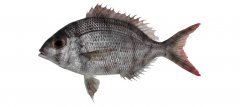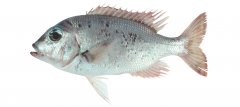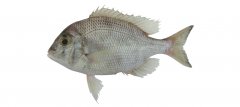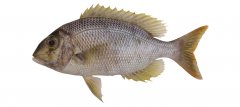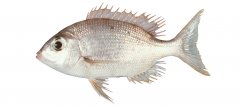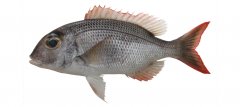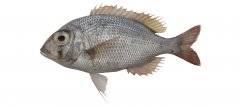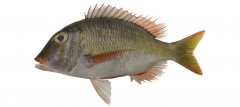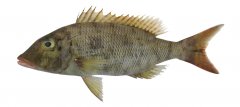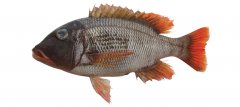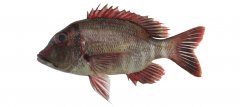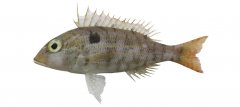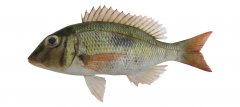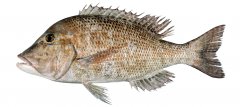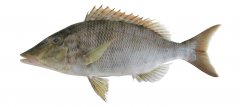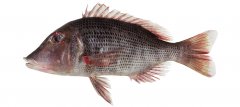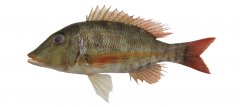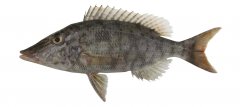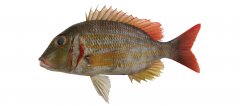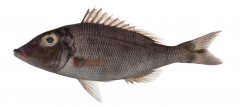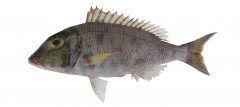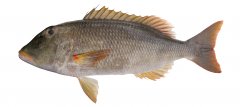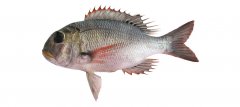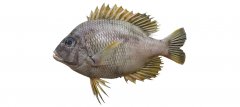Keys adapted from Carpenter, 20011 and Chen et al., 20172.
-
- Cheek naked; dorsal fin with 9 soft rays; anal fin with 8 soft rays Lethrinus species
- Cheek with 3–6 vertical rows of scales; dorsal fin with 10 soft rays; anal fin with usually 9 or 10 soft rays 2
-
- Inner surface of pectoral-fin base densely scaled; sides of jaws with round, flat molars Monotaxis species
- Inner surface of pectoral-fin base naked; sides of jaws with canines and villiform teeth (except Gymnocranius euanus which has molars) 3
-
- Outer surface of maxilla smooth Gymnocranius species
- Outer surface of maxilla with a denticulated ridge 4
-
- Caudal-fin lobes pointed; anal fin with 8 or 9 soft rays; pectoral fins with 15 rays Gnathodentex aureolineatus
- Caudal-fin lobes rounded; anal fin with 10 soft rays; pectoral fins with 14 rays Wattsia mossambica
-
- Caudal fin strongly forked, the median rays shorter than eye diameter; lower edge of eye intersected by line from tip of snout to middle of caudal-fin fork Gymnocranius elongatus
- Caudal fin moderately forked, the median rays about equal to, or longer than, eye diameter; lower edge of eye above line from tip of snout to middle of caudal-fin fork 2
-
- Longitudinal scale rows between lateral line and base of middle dorsal-fin spines 4½; molars present on sides of jaws Gymnocranius euanus
- Longitudinal scale rows between lateral line and base of middle dorsal-fin spines 5½; molars absent, usually villiform to conical teeth present on sides of jaws 3
-
- Snout with prominent blue-edged yellow band from front of eye to above upper lip (encompassing nostrils); 3 or 4 oblique blue lines across cheek; body moderately deep, the maximum depth about 2.3–2.4 times in SL Gymnocranius frenatus
- Snout without the marking described above; cheek may have wavy, blue lines or speckles, but the blue lines are more or less horizontal rather than oblique; body depth variable, 1.9–3 times in SL 4
-
- Inner edge of caudal-fin fork slightly convex with fin tips blunt Gymnocranius satoi
- Inner edge of caudal-fin fork straight and fin tips pointed 5
-
- Body comparatively deep, its depth about 1.9–2.4 times in SL; no blue spots or wavy blue lines on cheek; usually with several irregular dark bars on sides and dark subocular bar 6
- Body comparatively slender, its depth about 2.3–3 times in SL; side of snout and cheek often with vertically elongate spots or wavy longitudinal blue lines in specimens >200–250 mm SL; smaller specimens may have irregular dark bars on side and dark subocular bar 7
-
- Body depth about 1.9–2.3 times in SL; dark bar running from below sixth dorsal-fin spine to mid pelvic-anal space; 9–11 front scales on the top of head Gymnocranius griseus
- Body depth about 2.2–3.4 times in SL; dark bar running from below sixth dorsal-fin spine to origin of anal fin; 4–6 front scales on the top of head Gymnocranius obesus
-
- Body depth about 2.6–3 times in SL; cheek often with vertically elongate blue spots Gymnocranius microdon
- Body depth about 2.3–2.6 times in SL; juveniles below about 200 mm standard length frequently with dark bar under eye and 5 or 6 irregular dark bars across side of body; adults with wavy, blue lines on snout and cheek increasing in number with growth Gymnocranius grandoculis
-
- Second dorsal-fin spine distinctly longer than other dorsal-fin spines; a pair of canines in front of lower jaw substantially curved outward Lethrinus genivittatus
- Third, fourth, or fifth dorsal-fin spine the longest; canines in front of lower jaw almost straight or curved outward slightly 2
-
- Prominent bright red scaleless patch above base of pectoral fins Lethrinus conchyliatus
- No prominent scaleless patch above base of pectoral fins 5
-
- Membrane between innermost rays of pelvic fins covered with melanophores; 5–8 scales in supratemporal patch; lips yellowish and a red spot on upper base of pectoral fins Lethrinus xanthochilus
- Membrane between innermost rays of pelvic fins not mostly covered with melanophores; 7–10 scales in supratemporal patch; lips, upper base of pectoral fins, upper edge of opercle, sometimes posterior edge of preopercle, and sometimes an indistinct band on snout, reddish Lethrinus reticulatus
-
- Scale rows in transverse series below lateral line 13 or 14 (Fig. 38); posterior nostril a vertical slit, often closer to anterior nostril than to orbit; body very slender, its depth 3.2–3.9 times in SL Lethrinus variegatus
- Scale rows in transverse series below lateral line 15–17; posterior nostril a longitudinal slit closer to orbit than to anterior nostril, or about half-way between anterior nostril and orbit; body depth 2.8–3.4 times in SL 8
-
- 3 dark streaks radiating forward from eye on snout usually visible; inner surface of pectoral-fin surface never red Lethrinus microdon
- 3 distinct dark streaks radiating from eye not usually apparent, but if they are apparent, inner surface of pectoral-fin base is red 9
-
- Membranes between inner rays of pelvic fins mostly covered with melanophores, or with a limited part of innermost ray not covered by melanophores Lethrinus amboinensis
- Membranes between pelvic-fin rays closest to body without a dense covering of melanophores 10
-
- Wide scaleless area on upper posterior margin of opercle Lethrinus rubrioperculatus
- Upper posterior margin of opercle without wide scaleless area; 4–8 scales in supratemporal patch 11
-
- A large irregular black blotch on sides, bordering under lateral line and below soft portion of dorsal fin; 4–7 scales in supratemporal patch Lethrinus semicinctus
- No large black blotch on sides; 6–10 scales in supratemporal patch Lethrinus ravus
-
- Snout long, its length (measured without lip) 0.6–0.8 times in cheek height; body relatively slender, its depth 2.8–3.4 times in SL (for specimens over 100 mm SL) Lethrinus olivaceus
- Snout length (measured without lip) 0.8–1 times in cheek height; body depth 2.3–2.9 times in SL Lethrinus lentjan
-
- A large black blotch bordering below lateral line and centred on posterior tip of pectoral fins; usually 13 or 14 scale rows in lower series around caudal peduncle Lethrinus harak
- No dark blotch below lateral line; usually 15 scale rows in lower series around caudal peduncle (except in L. atkinsoni which also has 13 or 14 of these scale rows but differs from L. harak in having 4½ longitudinal scale rows between lateral line and base of fifth dorsal-fin spine, vs. usually 5½) 14
-
- The third, fourth, or fifth anal-fin ray usually the longest, much longer than length of base of soft portion of anal fin; length of longest anal-fin ray 0.8–1.1 times in length of entire anal fin 16
- The first or second anal-fin ray usually the longest, shorter than, approximately equal to, or slightly longer than length of soft portion of anal fin; length of longest anal-fin ray 1.1–1.8 times in length of base of entire anal fin 17
-
- Lateral teeth in jaws conical or rounded; lateral-line scales 46–48; membranes between inner rays of pelvic fins usually with densely distributed melanophores; small orange spots on head Lethrinus erythracanthus
- Lateral teeth in jaws usually with distinct molars; lateral-line scales 44–46; membranes between inner rays of pelvic fins usually not densely populated with melanophores; 2 light bars on caudal peduncle often visible Lethrinus erythropterus
-
- Angle of anterior snout relative to line of upper jaw 52–62°; lateral teeth in jaws conical; a bright red spot on outer base of pectoral fins Lethrinus miniatus
- Angle of anterior snout relative to line of upper jaw 65–80°; lateral teeth in jaws rounded or molars; no red spot on outer base of pectoral fins Lethrinus atkinsoni
-
- Melanophores covering most of pelvic-fin membranes, including near inner rays; blue spots and/or streaks radiating forward from eye Lethrinus nebulosus
- Melanophores absent from large portions of membranes between inner rays of pelvic fins 19
-
- Maxilla with a knob; angle of anterior snout relative to line of upper jaw 50–60° Lethrinus obsoletus
- Maxilla smooth or with a ridge; angle of anterior snout relative to line of the upper jaw 59–73° 20
-
- Snout relatively short and blunt, the preorbital 1.3–1.4 times in cheek height; angle of anterior snout relative to upper jaw line 64–73°; posterior edge of preopercle and opercle red; profile of head in front of eye usually convex Lethrinus ornatus
- Snout relatively pointed, the preorbital 1–1.3 times in cheek height; angle of anterior snout relative to upper jaw line 59–70°; posterior edge of preopercle not red (edge of opercle and base of pectoral fins sometimes red in L. lentjan); profile of head in front of eye nearly straight 21
-
- In adults, lateral teeth in jaws broadly rounded and sometimes with a pointed cusp, molars, or molars with a tubercle; body depth 2.5–2.9 times in SL; 15 or 16 scale rows between origin of anal fin and lateral line; posterior margin of opercle and sometimes outer base of pectoral fins red Lethrinus lentjan
- Lateral teeth in jaws conical; body depth 2.3–2.6 times in standard length; 16 or 17 scale rows between origin of anal fin and lateral line; no red markings on body Lethrinus laticaudis
-
- Lips red; no black spots at base of soft portion of dorsal fin; 12½ scale rows below lateral line to anal-fin origin; juveniles with narrow pale bars on sides Monotaxis heterodon
- Lips yellowish; usually with black spots at base of soft portion of dorsal fin; 13½ scale rows below lateral line to anal-fin origin; juveniles with broad pale bars on sides Monotaxis grandoculis
Lutjanidae
Snappers

Lutjanidae differ in having a preopercular margin usually serrate (vs. usually smooth ); branchiostegal rays 7 (vs. 6); dorsal-fin soft rays usually 11 or more (vs. 9 or 10); teeth usually present on vomer (vs. teeth absent); cheek scales present (vs. usually absent) and usually not fleshy (vs. lips frequently fleshy).
Nemipteridae
Threadfin bream
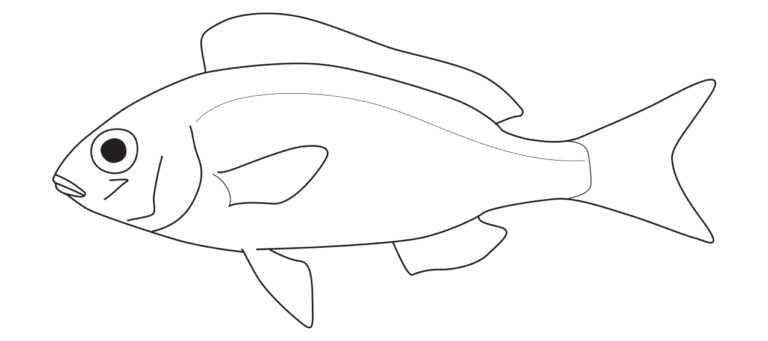
Nemipteridae differ in having anal-fin soft rays usually 7 (vs. 8–10); cheek scales present (vs. usually absent) and no molar-like teeth in jaws (vs. sometimes present).
Sparidae
Sea bream
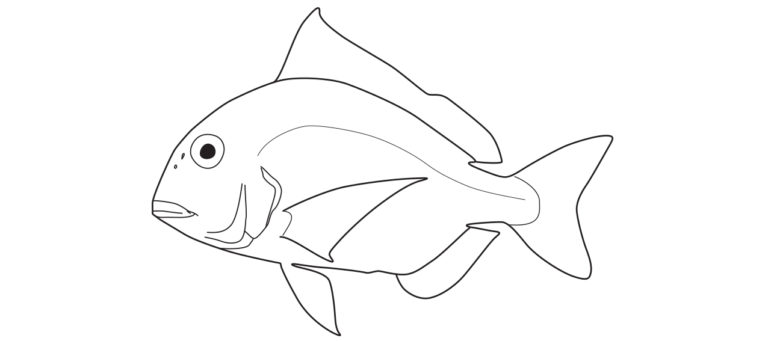
Sparidae differ in having rear tip of premaxilla overlapping maxilla at posterior end of mouth (vs. maxilla overlapping premaxilla); more than 10 dorsal-fin spines (vs. 10 dorsal-fin spines only); cheek always scaly (vs. naked in Lethrinus, but scaly in other genera).
Haemulidae
Grunts, sweetlips

Haemulidae differ in having scales present between eye and mouth (vs. scales absent); 2 or more pores present on chin (vs. no pores present on chin) and second anal-fin spine very strong (vs. moderate).
- Carpenter, K. Lethrinidae. in: Carpenter, K, Niem, V. FAO species identification guide for fishery purposes. The living marine resources of the Western Central Pacific. Volume 5. Bony fishes part 3 (Menidae to Pomacentridae). Rome: FAO; 2001;5:2791-3380.
- Chen, W, Miki, R, Borsa, P. Gymnocranius obesus, a new large-eye seabream from the Coral Triangle. In: Comptes rendus biologies. 2017;340(11-12):520-530.

